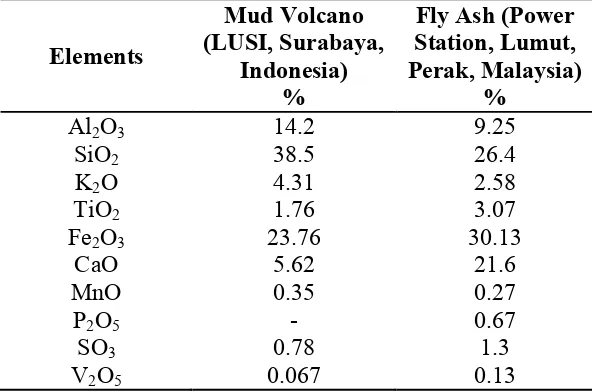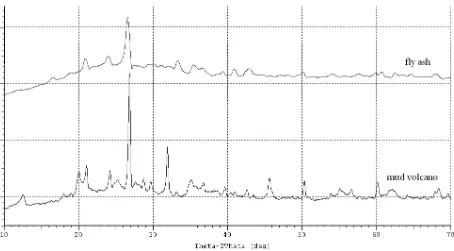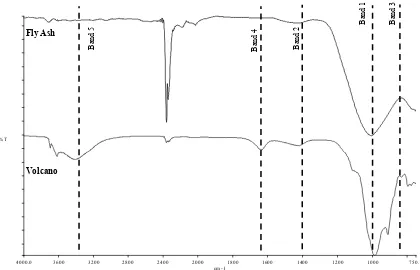Characterization of LUSI Mud Volcano as Geopolymer Raw Material
A. M. Mustafa Al Bakri
1, a, A. R. Rafiza
1, b,
D. Hardjito
2, c, H. Kamarudin
1, dand I. Khairul Nizar
3, e1
Centre of Excellence Geopolymer & Green Technology, School of Materials Engineering, Universiti Malaysia Perlis (UniMAP), 01000, P.O. Box, D/A Pejabat Pos Besar, Kangar, Perlis,
Malaysia
2
Civil Engineering Department, Petra Christian University, Jalan Siwalankerto 121-131, Surabaya 60236 Indonesia
3
School of Environmental Engineering, Universiti Malaysia Perlis (UniMAP), 02600 Jejawi, Perlis, Malaysia (Lumpur “mud” –Sidoarjo), East Java, Indonesia for characterization. Analysis showed that, the major constituents of mud are SiO2 and Al2O3 which are higher than those in fly ash. The particle of
mud has a flake-shaped particle and the overall particle size is dominated by particles between 2.5µm – 25.0µm. The results of XRD shows that mud of mud volcano have a characteristic of structurally disordered compounds, and a set of peaks corresponding to minor crystalline phases such as quartz, feldspars, and kaolinite. FTIR adsorption bands of the raw material of mud have the chemical bonding between bands 1-5.
Introduction
Mud volcano with an eruption site named ‘LUSI’ (Lumpur “mud” –Sidoarjo), East Java, Indonesia, has become a major issue since May 29, 2006 when it surfaced from the bowel of the earth and impacted an area of almost 770 hectare to a depth of 20 m, and thirty thousand people have been displaced which cost Indonesia $3.7 billion in damages and damage control [1, 2]. This disaster has become a controversial debate. It was caused by the drilling of a deep gas exploration well and impacted from the Yogyakarta earthquake of May 27, 2006 with a magnitude of 6.3 [3].The mud flows out continuously and it has covered not less than 770 hectare of productive land and has completely immersed many villages [4]. Experts expect the eruption to continue for years [5]. LUSI has attracted researchers to conduct the scientific studies to examine its natural and to explore an alternative effort to minimize its volume by producing the mud volcano products.
The geopolymer technology developed by Davidovits offers an attractive solution regarding this issue [6, 7]. Furthermore, geopolymer development desires to reduce greenhouse gas emissions from the production of concrete products. Past researches have shown that the performance of geopolymer concrete produces high compressive strength and greater durability than ordinary concrete [8-10]. It is also well known that geopolymers possess excellent mechanical properties, as well as fire and acid resistance [11, 12]. The pozzolan materials such as fly ash, metakaolin, or ground granulated blast slag, induced by high-alkaline solutions, can be used as total replacement for ordinary cement (Portland cement) to produce concrete [13-16].
The LUSI mud has degree matrix elements similar to pozzolan chemical compositions. Its natural characteristic, that contains silica and alumina element, can be categorized as a cement replacement material [17]. The aim of this study is to establish the characteristics of LUSI mud of mud volcano in East Java, Indonesia as a potential raw material for geopolymer composite.
Experimental Method
Study area. The present study was conducted on the mud collected from the eruption sites called the LUSI mud volcano near Sidoarjo, East Java, Indonesia. As of the fall of 2007, over 30 million m3 mud with temperatures ranging from 70-100°C had erupted, and the eruption continues until now (2012) and it is predicted to continue until 25 or more years.
Sampling. The material was collected from the eruption site and transferred into sealed container. The mud was medium gray in colour.
Laboratory Methods. Composite mud volcano samples were collected and analyzed for different parameters. X-ray fluorescence (XRF) was used to measure the chemical composition of mud volcano. X-ray diffraction (XRD) patterns were performed and this test was held to investigate the phase analysis of the original mud volcano. Scanning electron microscopy (SEM) was performed to investigate the microstructure and shape of the original mud volcano. Fourier Transform Infrared Spectroscopy (FTIR) was performed to determine the bonding between the particles in original mud volcano. All samples were prepared in powder form for testing purpose.
Results and Discussion
Chemical composition of mud volcano. The chemical composition of LUSI mud and fly ash as other pozzolanic material is shown in Table 1. The major constituents are SiO2 with 38.5% and
26.4% for LUSI mud and fly ash, respectively. The content of Al2O3 for both materials is 14.2%
and 9.25%. This shows that the content of silica and alumina in raw material of LUSI mud is higher than fly ash which is suitable to use as a raw material for geopolymer. However, the content of Fe2O3 for mud is merely lower than fly ash. The composition of Ca in mud of mud volcano is
significantly lower than fly ash. Others macro nutrients such as Ti, Mn and K for mud is comparable to the fly ash.
Table 1: Major chemical composition of the collected LUSI mud compared to fly ash.
Elements
Fig. 1: SEM pictures of: (a) LUSI mud; (b) fly ash.
XRD pattern. X-Ray diffraction (XRD) analyses of the mud compared with fly ash are shown in Fig. 2. Both starting materials exhibit a peak at 2 thetha where 2 thetha = 20º - 32º, which is characteristic of structurally disordered compounds, and a set of peaks corresponding to minor crystalline phases, i.e., quartz and faujasite, and mullite in the case of fly ash [18], meanwhile quartz, feldspars, and kaolinite in the case of mud. The peak at 2 thetha = 27° of mud shows slightly towards higher than fly ash due to higher composition of SiO2 in mud compared to fly ash. Geoffrey
S. [1] stated that the mud also dominated by smectite, illite, and mixed illite/smectite, with lesser kaolinite and chlorite.
Fig. 2: X-ray diffraction patterns of raw materials: (a) fly ash and (b) mud volcano.
Fourier Transform Infrared Spectroscopy (FTIR). Fig. 3 shows that the main FTIR adsorption bands of the raw materials of mud compared to fly ash from bands 1-5. The peak at band 1 due to the vibrations of 1090 cm-1 is due to asymmetrical stretching vibrations of Al-O/Si-O bonds, indicating the presence of Si and Al in the raw materials. As can be seen in Fig. 3, the depth of the
mud peak at band 1 is higher than fly ash due to high composition of Si and Al in raw material mud as shown in Table 1. The appearance of band 2 at 1410 cm-1 assigned to the stretching vibration of O-C-O. Meanwhile, for Si-O/OH, a bending band occurs at band 3 at the vibrations of 880 cm-1. The weak band seen between bands 4 and 5 characterizes the spectrum of stretching and deformation vibrations of OH and H-O-H groups from the weakly-bound water molecules, which are adsorbed on the surface or trapped in the large cavities between the rings of the geopolymeric products [19, 20].
4000.0 3600 3200 2800 2400 2000 1800 1600 1400 1200 1000 750.0
cm-1 %T
Volcano Fly Ash
Fig. 3: FTIR spectra of raw materials of LUSI mud and fly ash.
Conclusion
Analysis was carried out to explore the characteristic of LUSI mud of mud volcano as the potential benefits of the unstoppable mud flow. The results show that the chemical composition of mud has the major constituents of SiO2 and Al2O3 which is 32% higher than fly ash. The particle of LUSI
mud has flake-shaped particles and the overall particle size is dominated by particles between 2.5µm - 25.0µm. XRD analysis shows the minor crystalline structure such as quartz, feldspars, and kaolinite. The FTIR peaks indicated the existence of Al-O/Si-O, O-C-O and Si-O/OH bonding in original mud. Finding from this study shows that the LUSI mud of mud volcano has potential as a raw material in geopolymer system due to characteristic of mud which is comparable to the fly ash.
References
[1] A. Palomo, A. M., M. T. Blanco, F. Puertas. (1992). Physical, chemical and mechanical characterization of geopolymers. Paper presented at the Proceedings of the 9th International Congress of the Chem of Cem.
[2] B. V. Rangan, D. Hardjito, S. E. Wallah, & Sumajouw, D. M. J. (Eds.). Studies on fly ash-based geopolymer concrete. Curtin University of Technology, Perth, Australia.
[4] Cryanoski, D. (2007). Volcano gets choke chains to slow mud. Nature, 45, 470.
[5] Davidovits, J. (1994a). Global Warming Impact on the Cement and Aggregates Industries.
World Resource Review, 6, 263 - 278.
[6] Davidovits, J. (1994b). Properties of Geopolymer Cements. Paper presented at the Proceedings First International Conference on Alkaline Cements and Concretes, Kiev, Ukraine.
[7] Davidovits, J. (1999). Chemistry of Geopolymeric Systems. Paper presented at the Geopolymer '99 International Conference.
[8] Davies, R. J., Swarbrick, R.E., Evans R.J., Huuse, M.,. (2007). Birth of a mud volcano: East Java, 29 May 2006. GSA Today, 17, 4-9.
[9] Ekaputri, J. E., Triwulan. (2006). The Usage of Porong Mud as a Construction Materials. Paper presented at the National Conference.
[10] Geoffrey S. Plumlee, T. J. C., Handoko T. Wibowo, Robert J. Rosenbauer, Craig A. Johnson, George N. Breit. (2008). Preliminary Analytical Results for a Mud Sample Collected from the LUSI Mud Volcano, Sidoarjo, East Java, Indonesia: U.S. Geological Survey, Reston, Virginia. [11] Guo, X., Shi, H., & Dick, W. A. (2010). Compressive Strength and Microstructural
Characteristics of Class C Fly Ash Geopolymer. Cement and Concrete Composites, 32, 142 - 147.
[12] Jimenez, F., Monzo, M., Vicent, M., Barba, A., & Palomo, A. (2008). Alkaline activation of metakaolin-fly ash mixtures: Obtain of Zeoceramics and Zeocements. Micropor Mesopor Mater, 108, 41-49.
[13] Malhotra, V. M. (2002). Introduction: Sustainable Development and Concrete Technology.
Concrete International, 24, 22.
[14] Nuruddin, M. F., Bayuaji, R., Masilamani, M.B., Biyanto, T.R. (2010). Sidoarjo Mud: A Potential Cement Replacement Material. Civil Engineering Dimension, 12(1), 18-22.
[15] Palomo, A., Blanco-Varela, M. T., Granizo, M. L., Puertas, F., Vazquez, T., & Grutzeck, M. W. (1999). Chemical Stability of Cementitious Materials Based on Metakaolin. Cement and Concrete Research, 29(7), 997 - 1004.
[16] Ryuta H., K. S. (2009). Environmental Assessment of Natural Radioactivity in Soil Samples from the LUSI Mud Volcano, Indonesia. Environment Asia 2, 45-49.
[17] S. Hu, H. W., G. Zhang, Q. Ding. (2008). Bonding and abrasion resistance of geopolymeric repair material made with steel slag. Cement and Concrete Composites, 30(3), 239-244.
[18] Songpiriyakij, S. Effect of Temperature on Compressive Strength of Fly Ash-based Geopolymer Mortar, CON30-34.
[19] Surendra P. Shah, & Wang, K. (2009). Development of ‘Green’ Cement for Sustainable Concrete Using Cement Kiln Dust and Fly Ash. Paper presented at the International Workshop on Sustainable Development and Concrete Technology.


